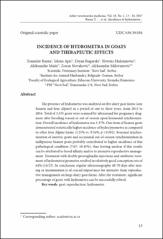Incidence of hydrometra in goats and therapeutic effects

View/
Date
2021Author
Barna, Tomislav
Apić, Jelena
Bugarski, Dejan
Maksimović, Nevena
Mašić, Aleksandar
Novaković, Zoran
Milovanović, Aleksandar
Metadata
Show full item recordAbstract
The presence of hydrometra was analyzed on five dairy goat farms (one
Saanen and four Alpine) in a period of one to three years, from 2013 to
2016. Total of 3,355 goats were scanned by ultrasound for pregnancy diagnosis
after breeding season or out-of-season upon hormonal synchronization.
Overall incidence of hydrometra was 1.37%. One farm of Saanen goats
demonstrated statistically higher incidence of hydro/pyometra as compared
to other four Alpine farms (3.25% vs. 0.56%; p <0.001). Seasonal synchronization
of anestric goats and occasional out-of-season synchronization in
nulliparous Saanen goats probably contributed to higher incidence of this
pathological condition (7/67; 10.45%), thus leaving unclear if this results
can be attributed to breed affinity and/or to intensive reproductive management.
Treatment with double prostaglandin injections and antibiotic treatment
of hydrometra/pyometra resulted in relatively good conception rate of
64% (16/25). In conclusion, regular ultrasonography 40-70 days after mating
or insemination is of crucial importance for intensive farm reproductive
management on large dairy goat farms. After the treatment, significant
percentage of goats with hydrometra can be successfully rebred.
